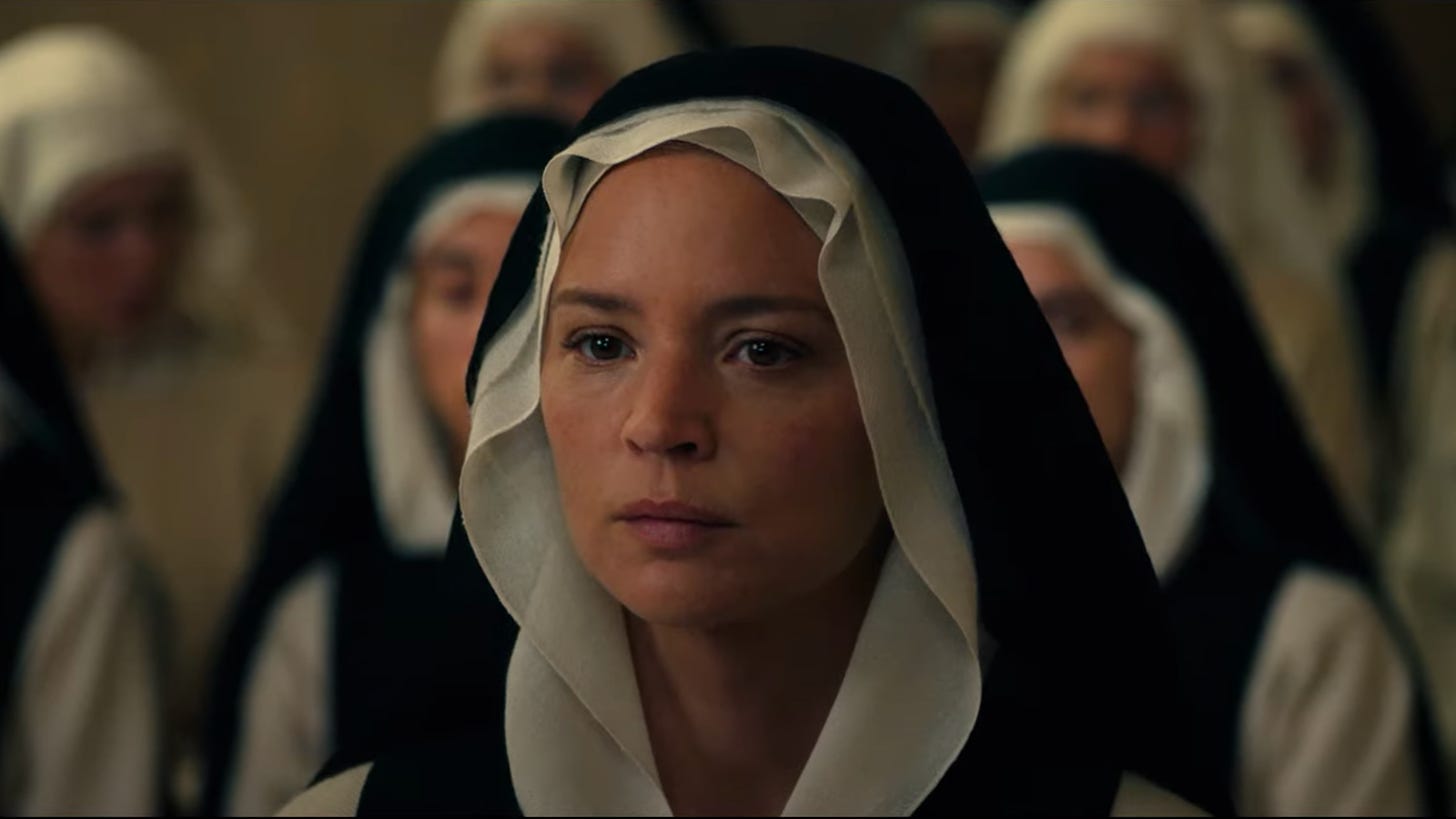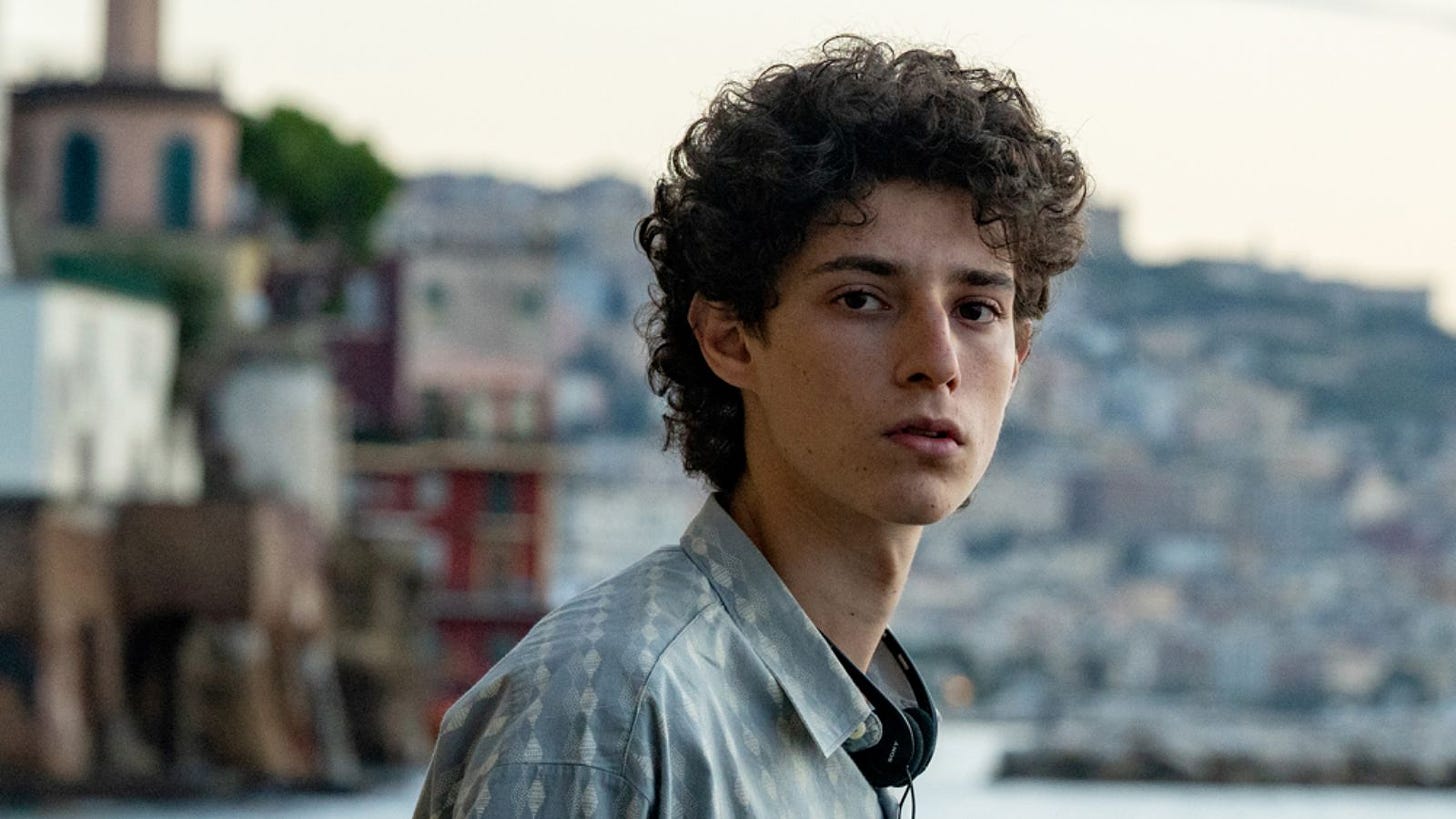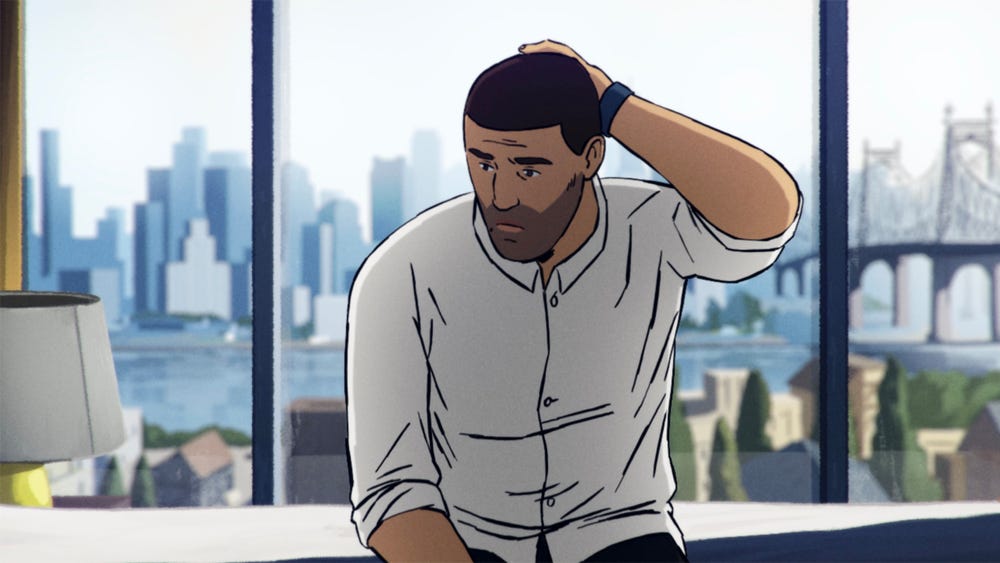In Review: 'Benedetta,' 'The Hand of God,' 'Flee'
Paul Verhoeven's foray into nunsploitation is sacralicious, Paolo Sorrentino revisits a bittersweet childhood, and a Danish animated doc tells the story of an Afghan refugee.
Benedetta
Dir. Paul Verhoeven
131 min.
As her father pays the dowry necessary to enter her into a Tuscan convent in 17th century Italy—a negotiation that itself is unseemly—young Benedetta Carlini is led into a room where she’s asked to give up her most cherished possession, a wooden icon of the Virgin Mary, and told to change into a burlap robe. When the child complains of its itchiness, the nun replies, “Your worst enemy is your body. Best not to feel at home in it.”
For director Paul Verhoeven, this is the ultimate outrage. His wildly provocative new film Benedetta could be dismissed as mere nunsploitation, with its blaspheming images of a Hitchcockian blonde in the throes of sapphic bliss, penetrated by a dildo carved out of a religious icon. And there’s no doubt that Verhoeven intends to poke the bear here, just as he has throughout a career that’s repeatedly manufactured controversy in Europe and Hollywood, from the arthouse to the multiplex. But Verhoeven is also a sincere, serious-minded director, and here he’s determined to reconcile the sacred and the profane, and to understand Carlini’s life as a battle against the repressive forces that stand between her and a more joyous and liberated spiritual existence. Sacrifice may be necessary, but shame isn’t.
On the road to the nunnery, young Benedetta stops to pray to the Virgin Mary, a chance for us to witness the type of relationship that she seeks to have with God, which doesn’t necessarily mesh with the rigors of Catholic dogma. When her family is confronted by bandits, she asks Mary for help, and a bird fluttering out to shit on the chief bandit’s head is proof enough that the girl has higher connections. The signs and wonders continue on her first night at the convent, when she sneaks out to pray in front of another statue of Mary, which suddenly crumbles and falls from its pedestal, miraculously not crushing her and leaving a stone boob exposed. Young Benedetta instinctively licks the nipple.
Cut to 18 years later. Benedetta has grown into a sensual wonder, played by Virginie Efira, who joins a long tradition of Verhoeven lust objects like Renée Soutendijk, Sharon Stone, Elizabeth Berkley and Carice van Houten. She appears to have integrated well into the convent, overriding the skepticism of the Abbess (Charlotte Rampling), but all that changes with the arrival of Bartolomea (Daphne Patakia), a young woman fleeing her father’s physical and sexual abuses. Though Bartolomea pledges her devotion to Jesus, there’s an almost feral wildness to her presence that stirs something within Benedetta, a sexual desire that’s connected to other forms of spiritual turbulence. If a woman’s body is an enemy, Benedetta is tempted to surrender to it.
The Reveal is a reader-supported newsletter dedicated to bringing you great essays, reviews and conversation about movies (and a little TV). While both free and paid subscriptions are available, please consider a paid subscription to support our long-term sustainability.
Verhoeven isn’t the type of director to underplay the sapphic charge between Benedetta and Bartolomea, who literally have a drop-the-soap moment as Bartolomea takes her first shower behind a translucent curtain. Male gazers get as much of an eyeful here as they would dropping coins into an old Time Square peepshow. But again, there’s a method to Verhoeven’s perviness. He revels in the grimy, vulgar realities of the period, where villagers roar in laughter over a performer lighting farts on a public stage and these two women share a latrine together, wiping their behinds with fistfuls of hay. As the plague ravages the landscape outside the village, the shame associated with bodies becomes absurdly disconnected from the gruesome torments visited upon them.
At times, Benedetta is a raw expression of the contempt Verhoeven holds for the priggish institutions that he’s been satirizing his entire career, full of scolds and hypocrites who bring nothing but misery to the people, women especially, that they’re morally policing. On those terms, the film is a juvenile delight, flush with steamy erotic energy, mystic visions, unexplained stigmata and frightening vocal possession, and thrashing ecstasies of pain and pleasure. But Verhoeven explores some ambiguities, too, particularly in Rampling’s Reverend Mother, who never knows what to make of Benedetta and falls into a serious crisis of faith. It isn’t easy for her to tell whether she has a heretic or a saint on her hands, and it shatters her received notions of what she believes and what her role in the Church is supposed to be.
In the end, that first impression of young Benedetta is the most lasting. Here’s a little girl who derives great fulfillment and pleasure from her devotion to the Virgin Mary. And the moment she enters the convent, and that pleasure is mediated by the strictures and corruptions of the Catholic Church, feels like a violation more troubling than a sacrilegious sex toy could ever be. — Scott Tobias
Benedetta is opening in limited release and Video On Demand on Friday.
The Hand of God
Dir. Paolo Sorrentino
130 min.
The title of Paolo Sorrentino’s bumpy cinematic memoir, The Hand of God, refers to an infamous goal in the quarterfinals of the 1986 World Cup match between England and Argentina in which the Argentine striker Diego Maradona, the greatest player in the world, scored on an uncalled hand ball that should have earned him a yellow card, but instead proved decisive in a 2-1 victory. After the match, when asked about the goal, Maradona said he scored “a little with his head, a little with the hand of God.” That’s how fate operates sometimes: Not always fairly, but the ball occasionally bounces in your direction. The Lord works in mysterious ways.
In the Naples of Sorrentino’s childhood, Maradona was himself a savior walking among humble mortals, a reason for hope and celebration in a city that was buckling under economic hardships and a crumbling infrastructure. But in Sorrentino’s bittersweet rendering, Maradona wasn’t his only memory of the hand of God significantly reshaping his world. He also lost both of his parents to carbon monoxide poisoning—and his own life was spared only because there was a soccer game that night and he had season tickets. Were it not for Maradona luring his teenage self to the stands, perhaps he would not have lived to tell his own story here. So score another goal for the maestro.
To date, Sorrentino’s career has been defined by a Fellini-esque bawdiness and maximalism, combined with an obsession over the arrogance and brokenness of the aristocratic class. Films like Il Divo and The Great Beauty have a thrilling robustness to them, with the director looking from the outside in, serving as both visionary impressionist and wry social commentator. But The Hand of God is a major charge of pace for Sorrentino, at least insofar as personal tragedy has tempered his wilder impulses. It feels like a notably mature work, but here “mature” belongs partially in scare quotes, because the film is a diffuse and only fitfully inspired slice-of-life, a patchwork of memories that don’t fit together as well as they should.
One great Sorrentino mystery has been solved, however: There’s a personal source for his love of boobs. At first, The Hand of God seems like an echo of the lusty nostalgia of Fellini’s Amarcord, just as The Great Beauty was his attempt to bring La Dolce Vita into Rome of the 21st century. But the boobs here belong to Aunt Patrizia (Luisa Ranieri), who Sorrentino’s virginal teenage surrogate Fabietto (Filippo Scotti) regards as the luscious ideal of Italian womanhood—a designation the unhappily married Patrizia does little to discourage. Early in the film, Fabietto and his parents, Saverio (Toni Servillo) and Maria (Teresa Saponangelo), are shown speeding through the night on a moped to Patrizia’s aid, as her violent husband (Massimiliano Gallo) is caught in the throes of suspicion and jealousy. The lesson for Fabietto is that even the seemingly blessed may not be as blessed as they appear.
The trouble with The Hand of God is common to autobiographical portraiture. Because the events are filtered through Sorrentino’s memory, his on-screen avatar, Fabietto, winds up a passive presence in own story, shaped by the actions of others. There’s a point late in the film when he emerges from the cocoon of grief and finds a purpose, but getting there involves sifting and drifting through recollections that aren’t always that compelling, especially those around an extended family that seems like an assortment of caricatures. (One of the many generously proportioned women in his family just sits down with a fan blowing in her face, eating great gobs of mozzarella cheese.)
Once Fabietto loses his parents, however, there are moments of piercing beauty between him and his older brother Marchino (Marlon Joubert), a failed actor who is nonetheless trying to eke some happiness out of the summer while not thinking about the future too much. For Fabietto, the past is now colored in a different light and beyond a newfound closeness to his brother, he has to cling hard to the remaining things worth caring about. Like boobs. And the movies. — Scott Tobias
The Hand of God opens in limited release this week. It premieres on Netflix on Dec. 15th.
Flee
Dir. Jonas Poher Rasmussen
90 mins.
Close your eyes and Flee, a new animated documentary from Danish filmmaker Jonas Poher Rasmussen, still works as the compelling story of a daring escape. Framed by a series of interviews between Rasmussen and Amin, a friend since Rasmussen’s teen years, it tells the story of Amin’s escape from Afghanistan as a child in the 1980s and subsequent life as a stateless refugee, a journey that eventually brought him to Copenhagen and into Rasmussen’s life. But it’s the way Rasmussen marries that story to animation that makes Flee so remarkable, even if the choice seems partly a practical decision. Amin is not Rasmussen’s friend’s real name, and his story reveals he has good reason to keep his identity obscured. Animation allows for that without hiding its subject in darkness.
It also opens up other expressive possibilities. Taking a page from Scott McCloud’s Understanding Comics and its observation that it’s easier for viewers and readers to identify with sparingly detailed art, Rasmussen uses simple figures rendered with no unnecessary details for much of Flee. He lets subtle changes in expression say more than words alone can and pauses Amin’s telling for dramatic recreations of moments from his journey. Some are poignant, like connecting with an attractive older boy while listening to Roxette in the back of a human trafficker's van, at a time when Amin is struggling to understand his sexuality. Some are chilling, as when Amin and his brother are released by the Russian police, not out of mercy but to give the cops a chance to rape a female refugee. The present day moments, by contrast, look touchingly mundane, like domestic scenes of Amin and his Danish partner and a shot of Amin staring out into the Danish streets. He never says he’s reflecting on how far he has had to come and how much he’s had to endure to enjoy such moments of calmness. He doesn’t have to.
Flee tells the harrowing tale of a disrupted childhood that doubles as a firsthand account of how humans can become pawns in international politics. But it also depicts the long-lasting effects of such an experience, the way Amin has felt the need to keep who he is so bottled up that Rasmussen only learns over the course of making the film that his friend has surviving family members he’s never spoken about before, lest he endanger the asylum requirement that he be without any living relations in order to enter and remain in the country. As the title suggests, it’s a film about escape but also about the weight of what gets packed away but never forgotten. — Keith Phipps
Flee opens in New York and Los Angeles on Friday.











I *adored* Benedetta; movie of the year so far for me. To be fair, I saw a preview screening at the Music Box and it was just a glorious movie going experience. There were right wing Catholic protestors out front (with a bagpipe!) and the crowd was hooting and hollering and raising the roof. I was sitting with three friends, all of us ex-Catholic, and we were all going absolutely nuts the entire movie.
Also, there's a thread in the movie that Scott doesn't mention, but that really resonated with me: Benedetta coming to see herself as not just as Christ's messenger but as Christ herself. There was a line Benedetta says near the end of the movie that caused me to just about jump out of my seat in shock and excitement: "it's fine, I had to be betrayed".
FLEE is this year's movie-I'd-never-heard-of-in-advance-of-its-release-that-I'm-most-excited-to-see. Animation has turned into such a potent documentary form -- I'm thinking not just of WALTZ WITH BASHIR but also 2016's TOWER.